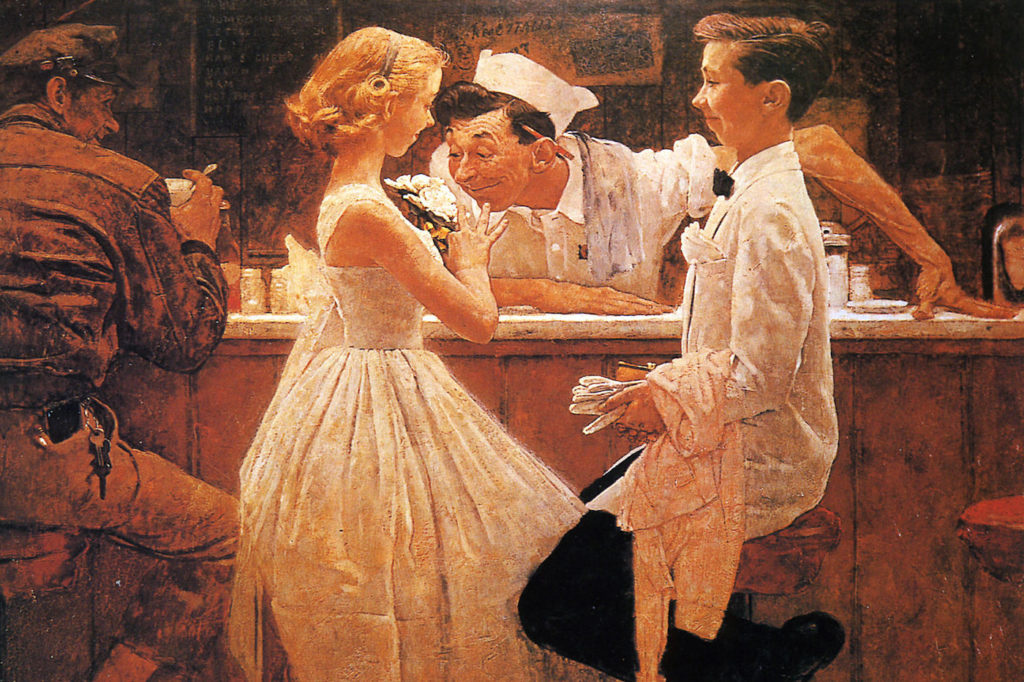When I was a child, my family would go to a local restaurant, a buffet place designed with a nostalgic country, fake “homey” theme. Per theme, the walls of the restaurant were decorated with enlarged prints of covers of the Saturday Evening Post, an American magazine that was published as a weekly from 1897 until 1963. The chosen covers were famously illustrated by Norman Rockwell.
I can still remember some of the restaurant’s prints. One was the recognizable No Swimming (1921). It depicted a group of boys, dripping with water and clutching their clothes while they ran. The boy in front has his head turned. His eyes are wide with his eyebrows raised, checking to see if an unseen property owner is still in pursuit of the group. Another was Tough Call (1948), where three baseball umpires, huddled together, look up at a dark cloud passing over the baseball stadium. One of the umpires stretches out his hand, feeling the drip of incoming rain.
Rockwell’s covers were well-received in their time and continue to be enjoyed. He was an excellent visual storyteller and with his knack for facial expressions and humorous body compositions tellingly illustrates the narrative. But, despite their popularity, Rockwell’s work is often written off as “kitsch.”
In his book Music as an Art, Roger Scruton contrasted Toni Braxton’s 1996 single, “Un-break My Heart,” which he describes as “kitsch,” with the pop music of the Beatles, a rock band he describes as “rhythmically articulate” and capable of “straightforward sentiment.” The suggestion is that pop music is not kitsch by virtue of being pop music and that it is capable of expressing real sentiment. Rockwell’s work may be “pop culture” rather than “high culture,” but like the music of the Beatles, I think his work is capable of real and “straightforward” sentiment.
Start your day with Public Discourse
Sign up and get our daily essays sent straight to your inbox.If pop culture is capable of straightforward sentiment, it need not completely be disregarded as kitsch. These works may not communicate new experiences in the way that transcendently beautiful works of art can, but they can still identify a joy within the mundaneness of ordinary life. This type of work goes beyond mere kitsch because it prepares us for greater works of art. Thus, we can rehabilitate Rockwell from the culture of kitsch because his body of work, expressing real sentiment, prepares us for greater experiences of beauty.
These works may not communicate new experiences in the way that transcendentally beautiful works of art can, but they can still identify a joy within the mundaneness of ordinary life.
Critiques of Rockwell’s Art
Rockwell’s work has long been criticized. Some disregard it as “low art” made for commercial purposes. Others criticize it for portraying an idyllic America that “never was,” unreflective of America’s pluralism (a pluralism that existed in Rockwell’s own time). Certainly, Rockwell’s cultural themes typically focus on white Americans. Religious themes are either generically Christian or vaguely Protestant. Class themes focus on people of comfortable means. Rockwell’s world is too pretty, too innocent, not real.
Defenders of Rockwell, on the other hand, typically cite his later work. They perhaps note that the Saturday Evening Post, whose covers Rockwell illustrated for forty-seven years, had placed serious artistic restrictions on Rockwell’s illustrations. Furthermore, early Rockwell is indicative of a certain time, an early-twentieth-century America that was already nostalgic for unspecified “good old days.” Later, in 1963, Rockwell would leave the Post for Look magazine. It was in his work with Look where Rockwell explored more serious themes, such as the civil rights movement.
Rockwell’s defenders will also cite The Problem We All Live With (1964) and Murder in Mississippi (1964) as counter examples of the accusation that Rockwell’s work is mere nostalgic musings. Later Rockwell provided a fuller picture of an America entering into the early Rockwell’s idyllic world. Rockwell’s 1967 painting New Kids in the Neighborhood, I think, is the best example of this.
Is Rockwell Kitsch?
But beyond the social context, Rockwell’s work is typically regarded as “kitsch.” Roger Scruton described kitsch as “an attempt to have your emotions on the cheap—the attempt to appear sublime without the effort of being so.” Elsewhere, he defines it as “fake art, expressing fake emotions, whose purpose is to deceive the consumer into thinking he feels something deep and serious, when in fact he feels nothing at all.”
Rockwell’s work expresses real sentiment, and remains a force of pop culture able to express real sentiment rather than just packaged sentimentality.
Perhaps Rockwell knew he was a maker of kitsch. When art critic Clement Greenberg was a student at Bennington College, he apparently traveled to Massachusetts to meet Norman Rockwell. Upon meeting Rockwell, Greenberg said “I’m so glad to meet you, Mr. Rockwell; you’re my idol,” to which Rockwell purportedly responded, “Mr. Greenberg, I would have hoped that you’d outgrown me by now.” Greenberg’s anecdote suggests that Rockwell is meant to be outgrown and that Rockwell himself wanted to be left behind by serious students of art.
Does Rockwell continue to persist simply because his work is consumer-friendly? That could certainly be a reason. Other reasons may include his technical proficiency and his socially significant thematic shifts. But, beyond those, I think Rockwell’s work (even his older work) contains value beyond being marketable. I do not attempt to argue that Rockwell is not kitsch. (I do not think I am capable of defending such a claim.) However, I do think Rockwell’s work expresses real sentiment, and remains a force of pop culture able to express real sentiment rather than just packaged sentimentality.
Real Sentiment
When I think of kitsch, I tend to think of commercial artists like Thomas Kinkade. Again, as a child, I found Kinkade’s paintings of cottages and cabins endearing. Kinkade marketed himself as the “Painter of Light,” using his proficient skill for contrasting natural and artificial light to create a “homey-ness.” Scruton and Greenberg would probably write off Kinkade’s work as kitsch for its manufactured sentimentality.
Kinkade’s paintings are inviting. Observers look into the painting with a feeling of sentimentality and fake nostalgia. But the observer can never be a part of the world communicated in the work. Observers may look into the painting and imagine what living in such a place might be like, but this is false nostalgia. Observers have never actually lived in such a place and their inclusion in the world would trample on its integrity. The charm of the painting is the fact that you, the observer, can never be a part of it.
We could say the same for Rockwell. Rockwell’s works sometimes evoke a fake nostalgia. Rockwell’s celebrated Freedom from Want (1943), depicts the happy faces of the family waiting for the holiday turkey. The smiles, however, are monotone and only vaguely contented. Everyone has the same smile, and no one is really saying anything. They aren’t happy about anything. They’re just happy.
But not all of Rockwell’s art is defined by empty nostalgia. Take a 1918 cover of the Saturday Evening Post entitled Children Dancing at a Party. The image depicts four children. In the front is a boy, recoiling from a girl. His eyebrows are apologetically raised—eyes wide, cheeks red, mouth slightly agape. The girl has also recoiled, but she is hunched over, grasping at her foot. Her brow is furrowed as she looks up at the boy, with an offended expression. It is quite clear that the boy has stepped on the girl’s foot while dancing. Behind this couple is another young couple, both amused at the misfortune of the first couple. The girl turns her head showing her toothy grin, but her wide eyes appear to indicate light amusement. This is in contrast to her dancing partner, a boy, whose narrow eyes and wide, boisterously laughing mouth reveal his delighted schadenfreude.
This print has always amused me. What evokes this response to the print is its depiction of the mundane—the little offenses and minute musings that make up most of the entertainment of everyday life. Rockwell’s work is humorous, and its humor comes from joy in the mundaneness of things.
For those of us desiring beauty, Rockwell’s work does not go far enough. It is not transcendent, seeking nothing more than the joy in the mundaneness of ordinary life.
Mundaneness and the Limits of Rockwell
Is there a place for mundaneness in art? Rockwell’s subject is mundane experiences, not sublime experiences like Bernini’s passionate depiction of religious experience in the Ecstasy of Saint Teresa. Perhaps dwelling in the mundane is the meaning of kitsch. If this is so, then Rockwell is certainly kitsch, as his work is designed to connect us with the world as we know it. Early Rockwell appeals to our niceties. It is meant to remind us of real sentiments rather than provide new experiences through works of art. Rockwell’s work is not challenging in the way that the Ecstasy is, and Rockwell is not transcendent in the way that Bernini is transcendent.
Is there beauty in the mundane? What is important is not just transcending the mundane, but finding the transcendent within the mundane. A great artist should be able to show the transcendent aspects of the mundane. I cannot say whether Rockwell was this type of artist—many of his works notably share in the manufactured sentimentality of kitsch.
But there’s a difference in Rockwell that makes him distinct from makers of kitsch. Rockwell, even early Rockwell, did express sentiment, real sentiment, not manufactured sentimentality. It depicts sentiments within the mundane joys of ordinary life, expressed in a way that evokes shared experiences in the observer. Rockwell goes beyond mere nostalgia. His work is not only a reminder of a time now gone, but of human experiences that have happened, are currently happening, and may happen again, in the observer’s life.
But for those of us desiring beauty, Rockwell’s work does not go far enough. It is not transcendent, seeking nothing more than the joy in the mundaneness of ordinary life. In the quest for sublimity, Rockwell cannot be the final stop. Perhaps we must learn to outgrow him. But outgrowing Rockwell does not mean we must abandon our appreciation for what his work was able to do. Unlike makers of kitsch, Rockwell is capable of creating art that expresses real sentiment. But Rockwell’s art is not the final stop. His work instead prepares us for more, to experience the sentiments expressed in a work rather than just to be charmed by an unreal, remote, and picturesque world.












